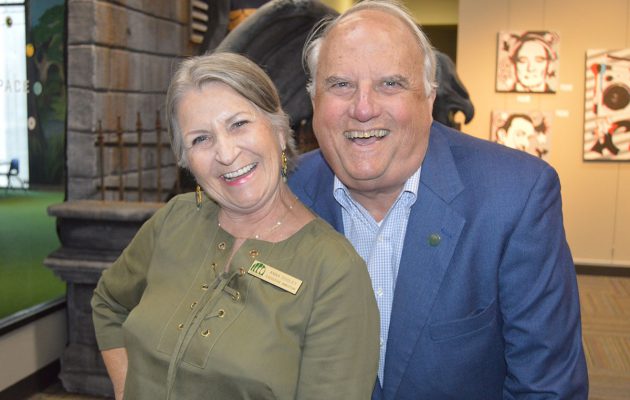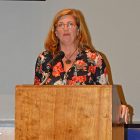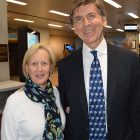Riverkeeper urges community to make sea-level rise a priority
Posted on December 5, 2018 By Editor Articles, Neighborhood News, Top Stories

Unless City elected officials move quickly to take precautions against sea-level rise and do comprehensive mitigation to counter the Jaxport dredging project, flooding of the kind experienced in downtown Jacksonville and its historic districts during Hurricane Irma – or worse – is likely to happen again a panel of experts agreed during a River Rising Town Hall at the Museum of Science and History Nov. 1.
“How many coastal cities in the world have political leadership that doesn’t even seem to acknowledge sea-level rise?” said one panelist. “We may be the only one. It might be a good start for the mayor and the City Council to just start talking about it.”
The event, sponsored by the St. Johns Riverkeeper, had a different twist from other town halls in the watchdog series because it was co-sponsored by Greenscape of Jacksonville. In addition to the upcoming dredging project, the discussion also centered around how green infrastructure – trees – can play an important role in alleviating flooding and other environmental concerns that impact the resiliency of urban communities.
Included on the panel were Nate Monroe and Christopher Hong, reporters at the Florida Times-Union, who have delved deep into the dredging issue by writing a special report entitled, “As the Ocean Creeps In.” Dr. Quinton White, executive director of Jacksonville University’s Marine Science Institute, and Richard Leon, manager of Urban Forestry for the City of Jacksonville, were also panelists. St. Johns Riverkeeper Lisa Rinaman moderated the event. E. Zimmermann Boulos, a San Marco resident and owner of Office Environments and Services, was the “community spotlight” speaker. Boulos spoke about the heavy expense he incurred when his furniture showroom in San Marco flooded during Hurricane Irma.
“Hurricane Irma was a wake-up call for Jacksonville, and not only to our vulnerabilities but also to the reality of rising sea levels,” Rinaman said, noting the Category 1 storm brought with it a Category 3 storm surge, taking the city off guard. “The infrastructure only made the situation worse, turning our river into a toxic soup of sewage and industrial waste. It’s time to learn from our past mistakes and take action. For more than a century, Jacksonville has continuously deepened and strengthened the St. Johns River, giving greater access to ships with a blind eye to the risk.
“As reported in the Florida Times-Union, a deeper and more efficient channel has allowed more salt water to travel up the St. Johns,” Rinaman continued. “It is bringing the ocean to our doorstep. Higher water levels and higher storm surge in our river increases the risk of flooding of our homes, businesses and public infrastructure. The current plan to dredge the St. Johns River an additional seven feet for 13 miles will only make these issues worse,” she said. “We have a choice to make here in Jacksonville. We can aggressively take action to make our community more resilient and more competitive, or we can allow our community to be more vulnerable to the threats of the 21st century.”
With his family business located on San Marco Boulevard since 1955, Boulos said he saw it flood during Hurricane Dora in the 1960s, when he was a child. Prior to Irma, he had set up a disaster location in a warehouse off Cassat Avenue, so he could continue business immediately if a catastrophic storm occurred, and waterproofed his facility as best as he could. Even so, 14 inches of water seeped inside his San Marco showroom, ruining his inventory and causing $600,000 in damage.
“I was fortunate to have $400,000 worth of flood insurance,” he said. “But when you write a check for $8,000 to $10,000 a year for 25 or 30 straight years spending a total of $300,000, and when it doesn’t flood, you begin to wonder why. Now, I know why,” he said.
In response to the Irma catastrophe, Boulos has since plugged holes in his building inadvertently caused by electricians and the cable company, spent $8,000-to $10,000 on new barriers, paint, and glaze for his windows, and increased his flood insurance to $700,000, which is the maximum he can get.
“I can do that once, but I can’t do it multiple years,” he said, noting it took him six months fix the damage and move back into his showroom. “If we flood one more time, I will stay in San Marco, but if it floods two more times, I will have to move to another part of the city, he said. “Flooding is too destructive to businesses. A lot of people in San Marco went out of business. They didn’t have flood insurance, and a lot of residences in the area really haven’t recovered.”
In doing research for their special report, Monroe and Hong said they discovered the upcoming dredging project will make the City more susceptible to storm surge. They said they were shocked to realize the U.S. Army Corps of Engineers simply considered inevitable the fact that the river will rise three to six inches and in some places as much as eight inches. “Without any sort of explanation, they found that to be insignificant and just wrote it off,” Monroe said.
Monroe also noted the natural state of the mouth of the St. Johns River was six feet at low tide, causing shallow boats to have to wait for favorable tides and winds before entering the river. Dredging the river channel has deepened it to 40-51 feet while removing grass beds and natural twists and turns – elements that create “friction” – that slow down the water.
White said since he moved to Jacksonville in 1976, he has watched the salinity of the river gradually change, and he discussed the reasons behind this and why the City is so susceptible to tide, wind and excessive rainfall. “It’s frustrating because our elected officials are just choosing to ignore it,” he said. “When you see events like Hurricanes Matthew and Irma, with Irma covering the entire state of Florida, the numbers are mindboggling,” he added, noting 22 trillion gallons of water fell on the state during Irma causing the entire land mass to be pressed down geologically by the weight of the water.
The reason Jacksonville floods so easily is because of its location and topography – it’s flat, White continued. “Most of the land in Downtown Jacksonville used to be marsh. Most of San Marco was marsh, and we’ve gradually filled it in. We’ve gradually deepened and channelized the St. Johns River. We’ve piled dredge along the shoreline to make it deeper. We’ve created a superhighway that allows water to race into the river,” he said, adding most “elected officials don’t look at the long-term consequences.”
Meanwhile, Leon said, as far as he is concerned, planting trees is the answer to every environmental and resiliency problem facing the City. “There is an old proverb, ‘When is the best time to plant a tree? Twenty years ago. When is the second-best time to plant a tree? Right now.’ I truly believe whatever the subject is – crime, health – trees are the answer,” he said.
Trees can help stop erosion, absorb water through their roots, and slow down the velocity of rain with their leaves helping to prevent sea-level rise. They also help infiltrate water into the Florida aquifer, he said, adding that trees should be considered as important a part of urban infrastructure as sewer systems, roads and bridges.
Jacksonville has applied for a grant with the Green Infrastructure Center and the Florida Forest Service to study how urban trees affect hydrology, Leon said. The study will help quantify how trees benefit the city’s resiliency and the results should be out in late spring, he said. He also invited the public to attend Tree Commission meetings at City Hall on the second and fourth Thursdays of every month.
Rinaman said District 5 Councilwoman Lori Boyer, who represents the San Marco area, spearheaded a bill, passed by the City Council in August, to set up a taskforce to study the need for resiliency and seek to understand what the city’s flood risk and drainage vulnerabilities are. Council President Aaron Bowman has yet to name members to the committee, she said, urging the crowd to weigh in with him about its importance.
“In downtown Jacksonville, the St. Johns River has risen five inches since the 1970s,” said Rinaman. “That is a serious increase, and with what the Army Corps is projecting with its dredging project, it will accelerate sea-level rise by 25 years, shaving 25 years off our planning horizon. Meanwhile, we are in a city that is not planning for sea-level rise.”
Shannon Blankinship, advocacy director for the Riverkeeper, said she hoped everyone would sign a petition demanding mitigation be coupled with the dredging project if it goes forward. Also on display at the back of the auditorium were letters from the Riverkeeper to Mayor Lenny Curry and Bowman suggesting specific actions that can be taken to address the City’s need for resiliency now.
Through a telephone call to San Marco Preservation Society President Bryan Mickler during the question and answer period, Andrew Dickson, former president of SMPS asked if planting more bioswales would help prevent street flooding during high tide in San Marco. “Regretfully there is not a lot you can do,” answered White, noting the city’s investment in expensive pump systems is not practical because the river is naturally rising. “What do you do when the place you are sending the water is sending you water?” he asked.
“We have to talk to our elected officials and let them know this [combating sea-level rise] is a priority for us,” White continued. “We’ve created a no-tax environment. I’m sorry, folks, this is going to cost us some money. You are paying for it already because the dredging project is a billion-plus dollars going out of your pocket.
“Flooding is going to keep happening because the city is flat, and the water has no place to go,” he continued. “Eventually insurance companies will quit giving businesses insurance or charge so much they will move. We are going to see this happen, and it will be faster than you think because the sea level is rising and climate change is real.”
By Marcia Hodgson
Resident Community News




 (No Ratings Yet)
(No Ratings Yet)









